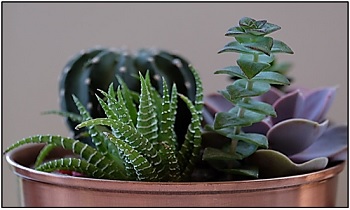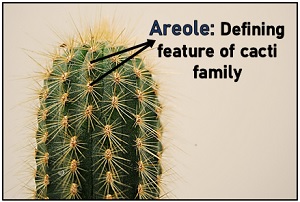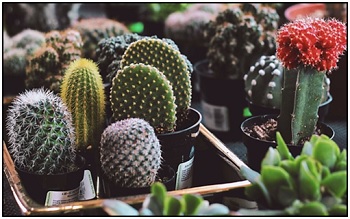The difference between succulents and cacti is mainly due to the following factors:
Presence of areole: Areole is a specialized structure from which spines, flowers, or fruits develops. Its presence is the characteristic feature of all cactuses, while unusual in succulents.
Phenotypic traits: All cactuses have a stem, whereas succulents possess a root system, stem and leaves.
The term succulent and cactus are sometimes interchangeable, but both can be discriminated by looking at their phenotypic traits, adaptations, habitat and growth pattern. Succulents represent a large group of drought-resistant and heat-loving plants, which includes 60 families.
Cactaceae is a succulent family that includes cactuses bearing a stem with spines or thorns but not leaves. Thus, we should remember that cacti can be succulents, but all the succulents cannot act like cacti.
Content: Succulents Vs Cacti
Comparison Chart
| Properties | Succulents | Cacti |
|---|---|---|
| Definition | They comprise root system, stem and fleshy leaves | They only comprise root system and stems |
| Areoles | Absent | Present |
| Leaves | They consist of green, thick and fleshy leaves | Absent |
| Spines | Spines originate directly from the leaf cuticle | Spines originate from specialized structures called areoles |
| Photosynthetic part | Leaves primarily participates in photosynthesis | Stems solely participate in photosynthesis |
| Adaptation | Succulents are adapted to grow in hot and dry conditions, as leaves, stems and roots can reserve water | In cacti leaves modify into spines that protect the plant body from direct heat, while stems modify to conserve water and participate in photosynthesis |
| Light exposure | Succulents cannot withstand prolonged light exposure | Cacti requires 4-6 hours of light exposure to grow |
Definition of Succulents
Succulents represent the plant community that store water in the root system stems and leaves. They resist drought conditions. Succulent plants possess thick leaves with a viscous substance inside them. It is derived from the word “succos”, which means “full of liquid sap”.
The gelatinous mucilage is nothing but a liquid sap that confers plants better resistance to dry conditions. Besides, succulents comprise modified leaves that range from a shiny, waxy surface to hairs and spines that prevent plants from losing water too quickly.
Succulents exhibit different growth patterns due to various leaf modifications. Another characteristic property of succulent plants is that they shrink during droughts and swell under adequate precipitation. It undergoes CAM (Crassulacean acid metabolism) photosynthesis that mainly occurs at a cooler temperature during the night to reduce water loss.
A succulent uptakes CO2 to facilitate photosynthesis during the day. The capacity of water absorption by the root system is usually low in extreme drought conditions. Leaves of purslane, juice of aloe vera, and agave plants are edible succulents with many health benefits.

Growth Conditions
Succulents grow in bright light but cannot live with prolonged warmth or may get leaf burn from excessive exposure to sunlight. A succulent plant must be planted in a terracotta or clay pot (preferable over a plastic pot) that gives excellent drainage and aeration.
Excessive watering can lead to root rot that ultimately causes plant death. A succulent plant must be kept away from extreme temperatures like excessive heat and frost.
Definition of Cacti
Cacti are succulent plants that only have stems, without leaves or branches. A cactus predominantly comprises spines, but few are spine-less. The presence of spines over the cacti skin is the spotifying feature because when we talk about cactus, anyone will instantly get an insight of cacti circumferenced with spines.

Areoles are the most defining feature of the cacti family, distinguishing it from the other succulent plants. They appear as ridges over the cacti’s surface from which flowers, hair, or spines originate. Thus, if a plant possesses spines but no areoles, it cannot be considered a cactus.
Cactus undergoes photosynthesis via green and fleshy stem, as it lacks leaves. The stems of the cacti family appear thick, hard-walled and either spongy or hollow. Stems preserve the water, and the waxy coating around the stem reduces its evaporation. Most cacti are native to arid deserts, and there are a few varieties that have a better tolerance to cold, such as the prickly pear cactus.

Growth Conditions
To plant cactus, periodical watering and yearly fertilizing isn’t even compulsory. Unlike succulents, cacti require exposure to light for at least 4-6 hours. We must use soil that offers good aeration and drainage system.
Excess moisture can cause root rot, but cacti require periodic watering during the time of flowering. In winter, you should hold off the watering. Cacti survive longer in dry conditions or warm temperatures but cannot thrive in icy conditions.
Key Differences Between Succulents and Cacti
- Succulents constitute a large group of drought-tolerant plants that consist of fleshy leaves, stem and a shallow root system. Cacti are heat-loving and drought-tolerant plants that belong to the Cactaceae family (a subcategory of succulent plants), which possesses a stem and a shallow root system.
- Cactus and succulent plants are not easily identifiable, but the presence of areole (small ridges) on the plant surface distinguishes the cacti family from the other succulents.
- Succulents have green, thick fleshy leaves insulated with gelatinous mucilage. In contrast, the leaves modified into spines in cactus plants, protecting them from heat damage and predators.
- The majority of succulents facilitate photosynthesis through the leaves, while in few stems can also participate. Conversely, the stem is the only part of the cacti family that mediates all the cellular activities, including photosynthesis.
- Succulents may get leaf burn due to prolonged light exposure. Oppositely, cactus plants require 4-6 hours of light exposure to remain alive.
Similarities
- Both succulent and cactus plants possess a shallow root system and grooved stems.
- The growth of succulents and cacti requires minimal care or maintenance and quite popular in home gardening.
- Both the plants follow slow growth patterns with varying shapes and sizes.
- Succulent and cactus belong to the category of ornamental plants due to their unique appearance.
Conclusion
Therefore, we can conclude that succulents and cacti adapt themselves to resist heat and dry climatic conditions. Both succulent and cactus plants cannot be differentiated easily, so the presence of areole on the plant surface generally discriminates the cacti family from the other succulents.
Cactus and succulent plants are generally kept inside the home, as these purify the air we transpire (CO2) and gives off the fresh air. In addition, both the plants are used to prepare herbal medicine and as a source of food or fodder etc.